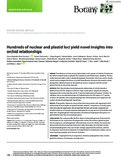| dc.creator | Pérez Escobar, Oscar Alejandro | |
| dc.creator | Dodsworth, Steven | |
| dc.creator | Bogarín Chaves, Diego Gerardo | |
| dc.creator | Bellot, Sidonie | |
| dc.creator | Balbuena, Juan A. | |
| dc.creator | Schley, Rowan John | |
| dc.creator | Kikuchi, Izai A. | |
| dc.creator | Morris, Sarah K. | |
| dc.creator | Epitawalage, Niroshini | |
| dc.creator | Cowan, Robyn | |
| dc.creator | Maurin, Olivier | |
| dc.creator | Zuntini, Alexandre | |
| dc.creator | Arias Garzón, Tatiana | |
| dc.creator | Serna Sánchez, Maria Alejandra | |
| dc.creator | Gravendeel, Barbara | |
| dc.creator | Torres Jiménez, María Fernanda | |
| dc.creator | Nargar, Katharina | |
| dc.creator | Chomicki, Guillaume | |
| dc.creator | Chase, Mark W. | |
| dc.creator | Leitch, Ilia J. | |
| dc.creator | Forest, Félix | |
| dc.creator | Baker, William J. | |
| dc.date.accessioned | 2021-11-17T20:19:54Z | |
| dc.date.available | 2021-11-17T20:19:54Z | |
| dc.date.issued | 2021 | |
| dc.identifier.citation | https://bsapubs.onlinelibrary.wiley.com/doi/abs/10.1002/ajb2.1702 | |
| dc.identifier.issn | 1537-2197 | |
| dc.identifier.uri | https://hdl.handle.net/10669/85241 | |
| dc.description.abstract | PREMISE: The inference of evolutionary relationships in the species- rich family Orchidaceae has hitherto relied heavily on plastid DNA sequences and limited taxon sampling. Previous studies have provided a robust plastid phylogenetic framework, which was used to classify orchids and investigate the drivers of orchid diversification. However, the extent to which phylogenetic inference based on the plastid genome is congruent with the nuclear genome has been only poorly assessed.METHODS: We inferred higher- level phylogenetic relationships of orchids based on likelihood and ASTRAL analyses of 294 low- copy nuclear genes sequenced using the Angiosperms353 universal probe set for 75 species (representing 69 genera, 16 tribes, 24 subtribes) and a concatenated analysis of 78 plastid genes for 264 species (117 genera, 18 tribes, 28 subtribes). We compared phylogenetic informativeness and support for the nuclear and plastid phylogenetic hypotheses.RESULTS: Phylogenetic inference using nuclear data sets provides well- supported orchid relationships that are highly congruent between analyses. Comparisons of nuclear gene trees and a plastid supermatrix tree showed that the trees are mostly congruent, but revealed instances of strongly supported phylogenetic incongruence in both shallow and deep time. The phylogenetic informativeness of individual Angiosperms353 genes is in general better than that of most plastid genes.CONCLUSIONS: Our study provides the first robust nuclear phylogenomic framework for Orchidaceae and an assessment of intragenomic nuclear discordance, plastid- nuclear tree incongruence, and phylogenetic informativeness across the family. Our results also demonstrate what has long been known but rarely thoroughly documented: nuclear and plastid phylogenetic trees can contain strongly supported discordances, and this incongruence must be reconciled prior to interpretation in evolutionary studies, such as taxonomy, biogeography, and character evolution. | es_ES |
| dc.language.iso | eng | es_ES |
| dc.source | American Journal of Botany, vol.108(7), pp.1166–1180 | es_ES |
| dc.subject | Angiosperms353 | es_ES |
| dc.subject | Incongruence | es_ES |
| dc.subject | Multilocus phylogenetic trees | es_ES |
| dc.subject | Nuclear- plastid discordance | es_ES |
| dc.subject | Orchidaceae | es_ES |
| dc.subject | Recombination | es_ES |
| dc.title | Hundreds of nuclear and plastid loci yield novel insights into orchid relationships | es_ES |
| dc.type | artículo original | |
| dc.identifier.doi | 10.1002/ajb2.1702 | |
| dc.description.procedence | UCR::Vicerrectoría de Investigación::Unidades de Investigación::Ciencias Básicas::Jardín Botánico Lankester (JBL) | es_ES |


